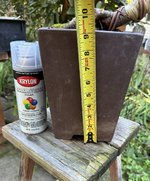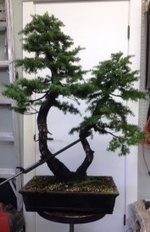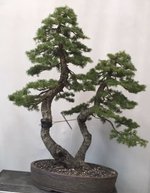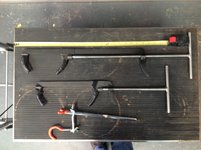Deep Sea Diver
Imperial Masterpiece
This Blue Atlas Cedar bonsai is one of the many trees owned by my Father in law. It was a full cascade then..
A couple years before Dad passed this tree (amongst others) was given to his oldest son. My better half and I repotted it over five years ago. Since then hadn’t seen the tree. A couple weeks ago he asked us to take eight of the trees, including this BAC. It’s at least 30 yoa.
Hasn’t been repotted since and has had minimal maintenance…. As one can see seven years of little work and the tree sprung up to almost a semi cascade. Sorry about the not great photo.

Secen years tree needs attention in a number of areas. Rebending, pruning and repot.
The first big job is to bend the trunk back into a full cascade. Not going to be an easy bend as-the main trunk has fattened up considerably over the years. Also BAC’s are notoriously sparingly beasts
This job called for raffia and double #6 wire. If we had some #4 would have laid one strand on it!
We both worked together laying out the raffia and wiring the trunk. We tried getting a complete bend on of the trunk right off but found out this job was going to need a guy wire and multiple attempts at bending. So we bent as much as possible tied it off, waited an hour and repeated three times. Here’s where we ended up.

The plan is to come back in a couple weeks and try to bend more again.
cheers
DSD sends
A couple years before Dad passed this tree (amongst others) was given to his oldest son. My better half and I repotted it over five years ago. Since then hadn’t seen the tree. A couple weeks ago he asked us to take eight of the trees, including this BAC. It’s at least 30 yoa.
Hasn’t been repotted since and has had minimal maintenance…. As one can see seven years of little work and the tree sprung up to almost a semi cascade. Sorry about the not great photo.

Secen years tree needs attention in a number of areas. Rebending, pruning and repot.
The first big job is to bend the trunk back into a full cascade. Not going to be an easy bend as-the main trunk has fattened up considerably over the years. Also BAC’s are notoriously sparingly beasts
This job called for raffia and double #6 wire. If we had some #4 would have laid one strand on it!
We both worked together laying out the raffia and wiring the trunk. We tried getting a complete bend on of the trunk right off but found out this job was going to need a guy wire and multiple attempts at bending. So we bent as much as possible tied it off, waited an hour and repeated three times. Here’s where we ended up.

The plan is to come back in a couple weeks and try to bend more again.
cheers
DSD sends















